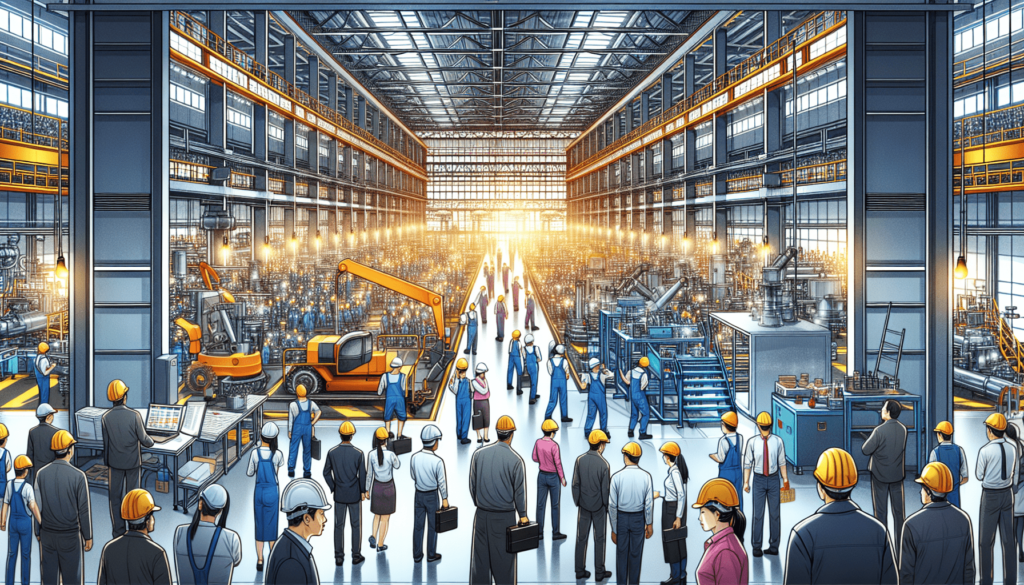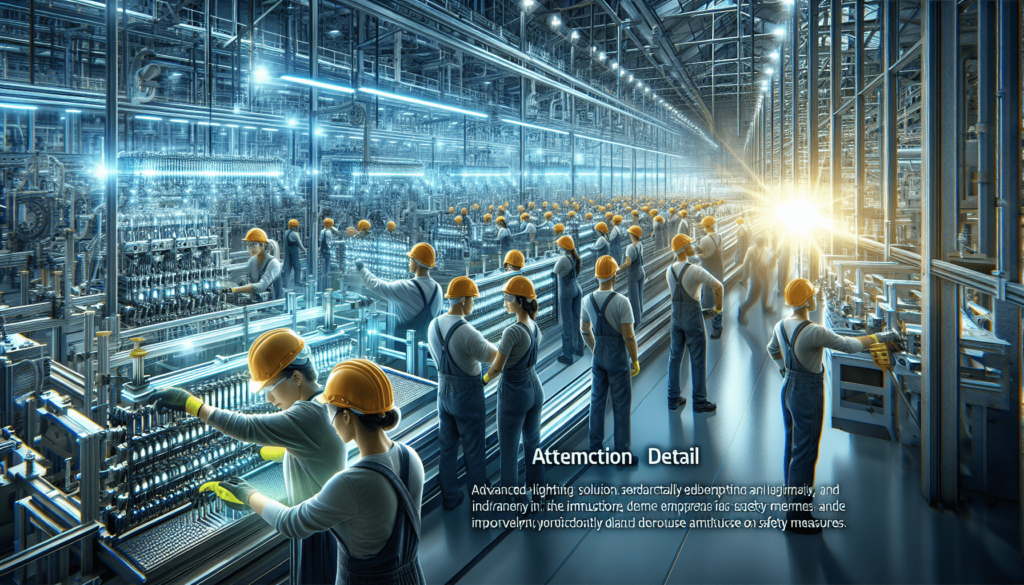Are you tired of dealing with dim lighting in your industrial workspace that hampers productivity and compromises safety? Look no further, because the answer to all your lighting woes lies in industrial lighting solutions. These innovative solutions not only enhance visibility but also contribute to a more efficient and secure working environment. By providing brighter and more consistent lighting, industrial lighting solutions are proven to boost productivity levels and reduce the risk of accidents. With their advanced technologies and customizable options, these lighting solutions are guaranteed to revolutionize your industrial space and take it to the next level.

The Importance of Industrial Lighting
Industrial lighting plays a crucial role in creating a safe and productive work environment. Proper lighting is not just about illuminating the space; it can have a significant impact on the well-being and efficiency of workers. In this article, we will explore the various benefits of industrial lighting, the different types of lighting solutions available, factors to consider when choosing the right lighting, and how it can improve productivity and ensure safety. We will also discuss the importance of proper installation, maintenance, and the potential cost considerations and return on investment. Additionally, we will glance at future trends in industrial lighting that are revolutionizing the industry.
Benefits of Proper Lighting in the Industrial Setting
Proper lighting in the industrial setting offers a multitude of benefits, ranging from improved productivity to heightened safety measures. Adequate lighting ensures that workers can perform tasks accurately and efficiently. It enhances visibility, reduces eye strain, optimizes workflows, and minimizes errors and accidents. Additionally, it creates a positive atmosphere, boosting employee morale and satisfaction. By investing in the right industrial lighting solutions, companies can significantly improve their overall operations and create a conducive work environment.

Impact of Inadequate Lighting on Productivity and Safety
Insufficient or inadequate lighting in an industrial setting can have detrimental effects on both productivity and safety. Poor lighting conditions can hamper visibility, making it difficult for workers to carry out their tasks effectively. This can lead to increased errors, fatigue, and eye strain. Moreover, inadequate lighting can create hazardous situations, as workers may not be able to identify potential dangers or navigate through the workspace safely. Ensuring adequate lighting is crucial to maximize productivity and mitigate the risk of accidents or injuries.
Types of Industrial Lighting Solutions
- High Bay Lighting:
High bay lighting is ideal for industrial spaces with high ceilings, typically ranging from 20 to 40 feet in height. These fixtures are designed to provide bright, uniform lighting over large areas. High bay lighting is commonly used in warehouses, manufacturing facilities, and gymnasiums.
- Low Bay Lighting:
Low bay lighting is suitable for industrial settings with lower ceilings, typically ranging from 12 to 20 feet in height. These fixtures are compact, but still provide sufficient lighting for smaller spaces or areas with lower ceilings. Low bay lighting is commonly used in workshops, garages, and smaller manufacturing facilities.
- Task Lighting:
Task lighting focuses on providing targeted illumination for specific workstations or areas where precise tasks are performed. This type of lighting ensures that workers have adequate lighting to perform their tasks accurately and efficiently. Task lighting is commonly found in assembly lines, laboratories, and inspection areas.
- Emergency Lighting:
Emergency lighting is crucial to ensure the safety of workers during unforeseen situations such as power outages or emergencies. These fixtures provide a reliable source of illumination to guide workers towards exits and emergency equipment. Emergency lighting is a legal requirement in many industrial settings to comply with safety regulations.

Factors to Consider in Industrial Lighting
When choosing industrial lighting solutions, several factors need to be considered to ensure the optimum lighting conditions and maximize the benefits.
- Brightness and Illumination Levels:
The brightness and illumination levels of the lighting fixtures should be appropriate for the specific tasks and working conditions. It is vital to strike a balance between providing sufficient light to see clearly without causing glare or discomfort.
- Color Temperature:
The color temperature of industrial lighting determines the hue and ambiance of the workspace. It has a significant impact on workers’ visual comfort and can influence mood and productivity. Cool white light (4000K to 6500K) is often used in industrial settings to promote alertness and focus.
- Energy Efficiency:
In the era of sustainability, energy efficiency is a key consideration for industrial lighting. LED lighting has become a popular choice due to its long lifespan and energy-saving capabilities. Energy-efficient lighting not only reduces operational costs but also contributes to a greener environment.
- Durability and Maintenance:
Industrial lighting fixtures are exposed to harsh environments, so durability is essential to ensure long-lasting performance. Choosing fixtures made of robust materials that can withstand temperature variations, vibrations, and moisture is crucial. Additionally, considering the maintenance requirements and ease of replacing components can help minimize downtime and maximize productivity.
- Lighting Controls:
Implementing lighting controls, such as occupancy sensors or daylight harvesting systems, can enhance energy efficiency by regulating lighting levels based on occupancy or natural light availability. Lighting controls provide flexibility and can be integrated with automation systems to optimize lighting operation.
Improving Productivity with Industrial Lighting
Proper industrial lighting significantly impacts productivity by providing the following benefits:
- Enhanced Visibility:
Well-designed lighting ensures that workers can see details clearly, which is crucial for tasks that require precision and accuracy. Adequate lighting reduces errors, speeds up workflow, and enables employees to perform their duties efficiently.
- Reduced Eye Strain and Fatigue:
Insufficient lighting or poor lighting quality can cause eye strain, leading to discomfort and fatigue. By providing adequate illumination, workers can avoid eye strain, allowing them to focus better and reduce the risk of mistakes or accidents.
- Optimized Workflows:
Lighting plays a vital role in optimizing workflows by providing the right amount of illumination in specific work areas. Task lighting, in particular, ensures that workers have sufficient light to perform intricate tasks while minimizing shadows and glare.
- Reduced Errors and Accidents:
Improved visibility and reduced eye strain result in fewer errors and accidents. Proper lighting allows workers to identify potential hazards and navigate the workspace safely, reducing the risk of injuries and costly accidents.

Ensuring Safety with Industrial Lighting
Industrial lighting is a critical component of ensuring a safe work environment. Here’s how it contributes to safety:
- Proper Illumination of Hazardous Areas:
Industrial facilities often have hazardous areas where specific safety precautions need to be taken. Adequate lighting in these areas ensures that potential hazards are visible to workers, allowing them to take necessary precautions and avoid accidents.
- Emergency Lighting for Evacuation:
During emergencies, such as power outages or fire incidents, well-placed emergency lighting systems guide workers to exits and emergency equipment. These lighting fixtures are vital for safe and timely evacuation, minimizing the risk of panic or injuries.
- Highlighting Safety Signs and Exits:
Proper lighting ensures that safety signs, exit signs, and evacuation routes are clearly visible. This aids workers in locating emergency equipment, understanding safety instructions, and easily identifying the exits in case of emergencies.
- Reducing Workplace Injuries:
Well-lit workspaces contribute to overall safety by reducing the risk of accidents and injuries. Proper lighting enables workers to operate machinery, handle tools, and navigate around obstacles safely.
Case Studies and Examples
Real-life examples of successful implementation of industrial lighting solutions showcase the positive impact it can have on productivity and safety. Implementing the right lighting solutions tailored to specific industrial environments can yield remarkable results.

Choosing the Right Industrial Lighting Solution
Choosing the right industrial lighting solution requires careful assessment and evaluation. Conducting a lighting audit can help determine the specific lighting needs and identify opportunities for improvement. Evaluating different lighting solutions and considering their long-term benefits, such as energy savings and maintenance costs, is vital in making an informed decision.
Installation and Maintenance
Professional installation of industrial lighting systems is crucial to ensure optimal performance and compliance with safety standards. Regular maintenance and inspections are necessary to detect and address any issues promptly. Upgrades and retrofit options should also be considered to enhance the performance and efficiency of existing lighting systems.
Cost Considerations and Return on Investment
While the initial investment in industrial lighting solutions may seem significant, the long-term benefits far outweigh the costs. Energy savings achieved through the use of energy-efficient lighting, combined with reduced maintenance and replacement costs, contribute to a favorable return on investment. It is crucial to consider the longevity and replacement costs of different lighting options to make an informed decision.
Future Trends in Industrial Lighting
The industrial lighting landscape is continually evolving, and several future trends are shaping its development:
- Smart Lighting and Automation:
The integration of smart lighting systems with advanced sensors, controls, and automation technology is revolutionizing industrial lighting. Intelligent lighting systems can adapt to occupancy and environmental conditions, optimize energy usage, and provide valuable data for facility management.
- Integration with IoT and Industry 4.0:
Industrial lighting is being integrated with the Internet of Things (IoT) and Industry 4.0 concepts to create interconnected and intelligent lighting networks. This integration allows for real-time monitoring and control, predictive maintenance, and energy management.
- Improved Sustainability and Environmental Impact:
Advancements in technology are driving the development of more sustainable lighting solutions. LED lighting, for example, offers energy efficiency, reduced environmental impact, and longer lifespan compared to conventional lighting options. The future of industrial lighting lies in continually improving sustainability and minimizing the carbon footprint.
In conclusion, industrial lighting serves a crucial role in enhancing productivity and safety in the workplace. Proper lighting solutions tailored to specific industrial settings can enhance visibility, reduce fatigue, optimize workflows, and minimize errors and accidents. By considering factors such as brightness, color temperature, energy efficiency, durability, and lighting controls, companies can choose the right lighting solution to meet their needs. Ensuring professional installation, regular maintenance, and evaluating cost considerations contribute to long-term benefits and a favorable return on investment. As technology continues to advance, the future of industrial lighting holds exciting possibilities, including smart lighting, integration with IoT, and improved sustainability. Embracing these trends will further revolutionize industrial lighting and create safer, more efficient, and sustainable work environments.



